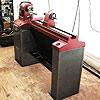
Originally Posted by
Shawn Patel

I think you are right, Mreza. It's easiest to see yr point if the template were a perfect circle. (a) would have a diameter equal to (t), but (b) would have a diameter (a) + (r).
To correct for this, then I ask you, can you do it like inlay template kits?
First, you route (a) with the template on top, using a bushing with an offset equal to the radius of the router bit.
Then for (b), you remove the bushing, and route it like I said below.
This seems to work for inlays. Would it work here?





 Reply With Quote
Reply With Quote






